- STATANT
- See Appendix VI.
- STATE ARMS (or COAT OF ARMS)
- See under arms.
- STATE COLOURS (or COLORS)
- 1) See national colours.
- 2) A special mark of distinction carried by some foot regiments of the British
Brigade of Guards but see
second colour (also
'colour 2)',
colours 2) and
royal standard 3)).
- 3) The colours selected by a sub-national entity particularly if the entity
is called a state - as representative of that entity - landesfarben (see also
livery colours,
state flag 2)
and sub-national flag).
- 4) In US military usage a term, now obsolete, for one of the colours carried
by a unit of state militia or volunteers (usually when mustered into federal service)
as the second colour along with a national colour of the same design as that used
by regiments of the regular army.
- STATE ENSIGN
- See government ensign under 'ensign'.
- STATE FLAG
- 1) A variant of the national flag (or occasionally a completely different
design) which is restricted by law or custom (theoretically or actually) to use
by a country's government, and can often differ from the national flag by the
addition of a coat of arms or emblem the government flag or federal service
flag (see also
civil flag,
coat of arms,
emblem, national and
national flag, together with government
ensign and naval ensign listed under ensign).
- 2) The flag of a territorial sub-division within a country, especially
when that subdivision is called a state. To avoid confusion with 1) however,
such a flag should normally be more precisely referred to as the flag of the
state of (see also anti-heraldry,
military crest,
seal,
state colours 3) state service flag and
sub-national flag).
![[three state flags]](../images/v/vxt-d313.gif)
From left: State Flag of Lithuania (fotw); State Flag of Peru
(fotw); Flag of the State of Tennessee, US (Graham Bartram)
- STATE MILITARY CREST
- See military crest.
- STATE SERVICE FLAG
- A term describing those flags of particularly (but not exclusively) German or Austrian states - or Lδnder -
that are intended for official as opposed to civil use (see also ceremonial flag
1),
official flag 2),
state flag 2)
and sub-national flag with following notes).
![[Federal Service Flag of Germany]](../images/v/vxt-d412.gif)
From left: The State Service Flag of Saxony; The Civil Flag of Saxony, Germany;
The State Service Flag of Styria; The Civil Flag of Styria, Austria (fotw)
- STAYED MAST
- A heavy high mast supported by means of stay cables. Stayed masts are often
erected at sea training establishments with proper main and top yards for seamanship
training purposes or at yacht clubs, and are fitted with a main yard gaff for
the hoisting of an ensign (see also
ensign,
gaff,
peak,
sailors mast and
yard).
- STICKPIN (or STICK PIN) FLAG
- See lapel flag 1).
- STEPPED FLY
- 1) (adj) A term for the type of flag, now largely (if not wholly) obsolete, whose fly is
extended by a rectangular projection (smaller in width and of varying length) centred on the
horizontal meridian of the flag (see also
fly 1),
meridian,
schwenkel and
tongues).
- 2) See stepped gonfalon below.
A selection of 19th Century US House Flags (CS)
![[stepped flags]](../images/v/vxt-d314.gif)
|
![[stepped flags]](../images/v/vxt-d314a.gif)
|
![[stepped flags]](../images/v/vxt-d314b.gif)
|
![[stepped flags]](../images/v/vxt-d314c.gif)
|
Please note, this was not considered an established term and had been
introduced by the Editors as no (accurately descriptive) established alternative could then be found,
however, since that time the Italian term gonfaloni scalinati has been discovered and is accordingly
defined below.
- STEPPED GONFALON
- (adj) The term (and a direct translation of the Italian gonfaloni scalinati) that may be used to
describe those gonfalons whose fly forms a series of steps as in the examples given below (see also
gonfalon).
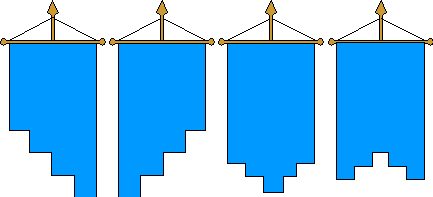
Asymmetric Right (or Dexter) Stepped; Asymmetric Left (or Sinister) Stepped; Symmetrical Outwardly Stepped; Symmetrical
Inwardly Stepped
- STORM FLAG (or ENSIGN)
- 1) Specifically, in US military usage, the smallest size of national flag flown at army
posts - 5 feet (1.5 m) wide by 9 feet 6 inches (2.9 m) long, or half as wide and
half as long as a post flag (see also
garrison flag
and post flag).
- 2) Generally, a smaller size of flag than that laid down for general use, and meant to
be flown in stormy weather.
- 3) See storm warning flag below.
- STORM WARNING FLAG
- In US and some other usage, one of a system of flags and pennants used to
warn mariners of severe weather in the area (see also
beach flag).
- STREAMER
- 1) A long narrow ribbon attached to a flags staff, such as those upon which
battle honours are inscribed (see also
award streamer,
banderole,
battle honour
and streamer retaining ring).
- 2) A term, now obsolete, for a long narrow flag or pennant, often
stiffened with a frame, and flown from a vessel as decoration
(see also frame 2),
masthead pennant 2)
and pennant 2)).
Please note with regard to 2) that streamers supplied to the
Henry Grace a Dieu (flagship of the English royal fleet) in 1514 are recorded as having
ranged between 15 and 51 yards (13.5m and 46m) long.
- STREAMER RETAINING RING
- An often decorative, ridged band sometimes fitted to the staff of a military
colour below the finial, and from which battle streamers are suspended (see also
battle honour,
colour 2),
staff 2) and streamer 1)).
- STRIKE (A FLAG)
- (v) A largely nautical term meaning to lower or haul down a flag, particularly
(but not exclusively) as a sign of surrender.
- STRIPE(S)
- A band or bands of colour whether disposed vertically, horizontally or
diagonally which generally reach one or more edges of a flag, but which do
not cover the whole area see striped (also
multi-stripe,
triband,
tricolour and
bicolour).
Please note that the most common heraldic terms
used in describing the stripe on a shield or banner of arms are listed separately
and/or in Appendix VI, however, it is suggested that
suitable a glossary or heraldic dictionary be consulted for further details.
- STRIPED
- The term used to describe a flag having more than two parallel bands of colour whether
disposed vertically, horizontally or diagonally but see
multi-stripe,
stripe,
triband, and
tricolourtricolour (also
bicolour).
- STUMPMAST (or STUMP MAST)
- A truncated mast (see also flying line,
and
mast 1)).
Please note that a stumpmast with a fixed yard at the
truck giving it a T-shape is common right forward in the bows of those bulk cargo
carrying vessels plying the inland waterways of Europe so as to allow for passing
under bridges and other overhead obstructions. The taller of this type of mast is
also often hinged for lowering to deck level for the same purpose (see also
'truck' and
'yard').
- SUB-NATIONAL FLAG
- A generic term for the flag of any territorial division within a sovereign
or independent country or within a federated state, that is subordinate to the
national flag of that country or federated state a constituent state, province,
county, municipality or similar (see also
civic flag,
cantonal flag,
national flag,
state flag 2) and
tribal flag).
Please note however, that the flags of the constituent
parts of the UK those of England, Scotland and Wales although subordinate
to the Union Flag are also national flags under the law. Similar situations may,
however, exist in other countries, and the applicable country's laws should be
consulted to determine the status of such flags (see also
union jack).
It should be noted also, that in the sub-divisions
of some countries such as the Lδnder of Germany or provinces of Spain there
are variants of the state or provincial flags for civil and official use - but
see ceremonial flag 1),
'state service flag'
and official flag 2) (also
civil flag).
|
![[subnational flag]](../images/v/vxt-d315.gif)
Civil Flag La Rioja
|
![[subnational flag]](../images/v/vxt-d315a.gif)
Official Flag La Rioja,,Spain (fotw)
|
- SUBVERTED (or SUBVERTANT)
-
- See reversed 2).
- SUIT (or SUITE) OF FLAGS
- The ensign, jack and masthead pennant of a commissioned warship (see
ensign,
jack and
masthead pennant 1)).
- SUN-IN-SPLENDOUR (or IN-GLORY)
- The heraldic term for a sun that has alternating straight and wavy rays, and which often (although not
invariably) shows a face but see active and inactive
and sunburst.

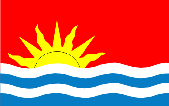
Flag of Corneaux, Switzerland (fotw); Flag of Kolobrzeg, Poland (Jarig Bakker)
-
- SUNBURST
- The term used when a (usually but not invariably) rising sun is shown complete with its
rays but see radiating 1) and
sun in splendour (also active,
active and inactive and
inactive).
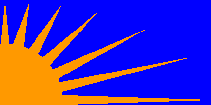
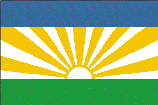
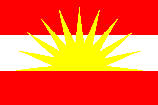
A Sunburst Banner of Ireland (fotw): Lebowa Homeland, South Africa 1972 1994 (fotw); Crops Commander,
Pakistan (fotw)
- SUNDAY ENSIGN
- A term used in the British Royal Navy and some others, to describe an ensign
larger than the normal daily size that is flown on ships and at naval establishments
on Sundays and/or days of national celebration a ceremonial ensign or flag (see
also ceremonial ensign and
holiday colours).
Please note that it this is not to be confused with
a flag of ceremony (see also
'indoor flag and
'garrison flag').
- SUNSET (THE CEREMONY OF)
- The ceremony of lowering the ensign and jack particularly (but not exclusively)
aboard a warship or naval shore establishment at the local time of sunset or at
a specified time at the end of a working day - conducting or making sunset or
evening colours (see also
colours 5) and
retreat ceremony).
- SUPERIMPOSED
- See surmounted by.
- SUPPORTERS FLAG/PENNANT
- See sports flag 2).
- SUPPORTERS
- Human or animal figures placed either side of a shield in a set of armorial
bearings - see also Appendix IV
& Appendix V (also
armorial bearings,
coat of arms
and heraldic beasts).
- SUPRA-NATIONAL (or SUPER-NATIONAL) FLAG
- The flag of an organization, some aspects of whose authority and/or influence
transcend national sovereignty, as in for example, that of the United Nations
or European Union (but see also
international flag,
Geneva Convention flag and
safe conduct flag
- SURFING FLAG
- See beach flag.

Surfing Flags UK and France (fotw)
- SURMOUNTED, BY
- 1) In vexillology a term that may be used when one charge is placed above or at the
top of another but see note below (also charge 1)).
- 2) In heraldry the term used when an ordinary or a charge (or charges) is
(or are) placed over that is in front of another as per the examples given
below, and which generally (although not exclusively) touches the field but see
debruised and
overall 2)) (also
charge 1),
ensigned and
ordinary,
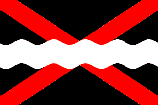
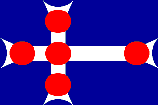
Flag of Santa Eulΰlia de Riuprimer; Spain (fotw); Flag of Vilabertran, Spain (fotw)
Please note that the correct heraldic term for a charge (such as a crown or coronet)
placed above rather than over- that is in front of - another is ensigned.
Also please note, it is suggested that a glossary or dictionary or heraldry be consulted with regard to comparative
use of the terms overall and surmounted by.
- SURTOUT
- See overall 2).
- SWAG (or SWAGGED)
- See fan (also bunting 2)).
- SWALLOW-TAIL(ED)
- 1) A V-shaped cut in the fly of a flag or pennant and forming two points - but see
'double pointed' (also
crutch
fly 1),
indentation(s),
orthogonal,
palm and
hussar cut).
- 2) A flag or pennant having such a cut in the fly.
![[a swallowtail flag]](../images/v/vxt-d317.gif)
Naval Ensign of Germany (fotw)
- SWALLOWTAIL AND TONGUE
- A flag as above, but having a third tail between the other two and so coming
to three points at the fly - triple-tailed or tongued, or three-tongued or
double-swallowtail (see also
indentation(s)
palm,
square-tongued,
triangular-ended tails,
tongue(s) and
triple-tailed 2)).
![[Norway naval ensign - a tongued swallowtail]](../images/v/vxt-d319.gif)
![[Swedish naval ensign]](../images/v/vxt-d319a.gif)
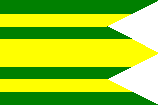
From left: War Flag/State Flag/Naval Ensign of Norway (fotw); Naval Ensign of Sweden (fotw);
Flag of Bajc, Slovakia (CS)
- SWASTIKA
- An ancient symbol in the form of an equal-armed cross with each arm continued at
a right angle, presently used (running anti-clockwise) as the emblem of a Chinese
humanitarian organization founded in 1922, (in a clock-wise form) on the presidential
flag of Finland, and until 1945 as the emblem of the German Nazi Party a
crooked/hooked cross or fylfot (see also appendix VIII and
cross 2)).
![[swastika examples]](../images/v/vxt-d320.gif)
From left: China, 1922 - (CS); The National Flag, Germany 1933-45; The Presidential Standard of Finland (fotw)
- SWORD KNOT
- See dress knot.
- SYMBOL
- 1) Generically, the flag, coat of arms, emblem or badge that may be considered representative or symbolic
of a nation, people, organization or cause see
badge 1),
coat of arms 1),
emblem 1),
emblem, military or governmental and
emblem, state or national.
- 2) Specifically, see Logo 1).
![[three state flags]](../images/v/vxt-d313.gif)
![[Federal Service Flag of Germany]](../images/v/vxt-d412.gif)
![[stepped flags]](../images/v/vxt-d314.gif)
![[stepped flags]](../images/v/vxt-d314a.gif)
![[stepped flags]](../images/v/vxt-d314b.gif)
![[stepped flags]](../images/v/vxt-d314c.gif)








![[Norway naval ensign - a tongued swallowtail]](../images/v/vxt-d319.gif)
![[Swedish naval ensign]](../images/v/vxt-d319a.gif)

![[swastika examples]](../images/v/vxt-d320.gif)

![[subnational flag]](../images/v/vxt-d315.gif)
![[subnational flag]](../images/v/vxt-d315a.gif)

![[a swallowtail flag]](../images/v/vxt-d317.gif)